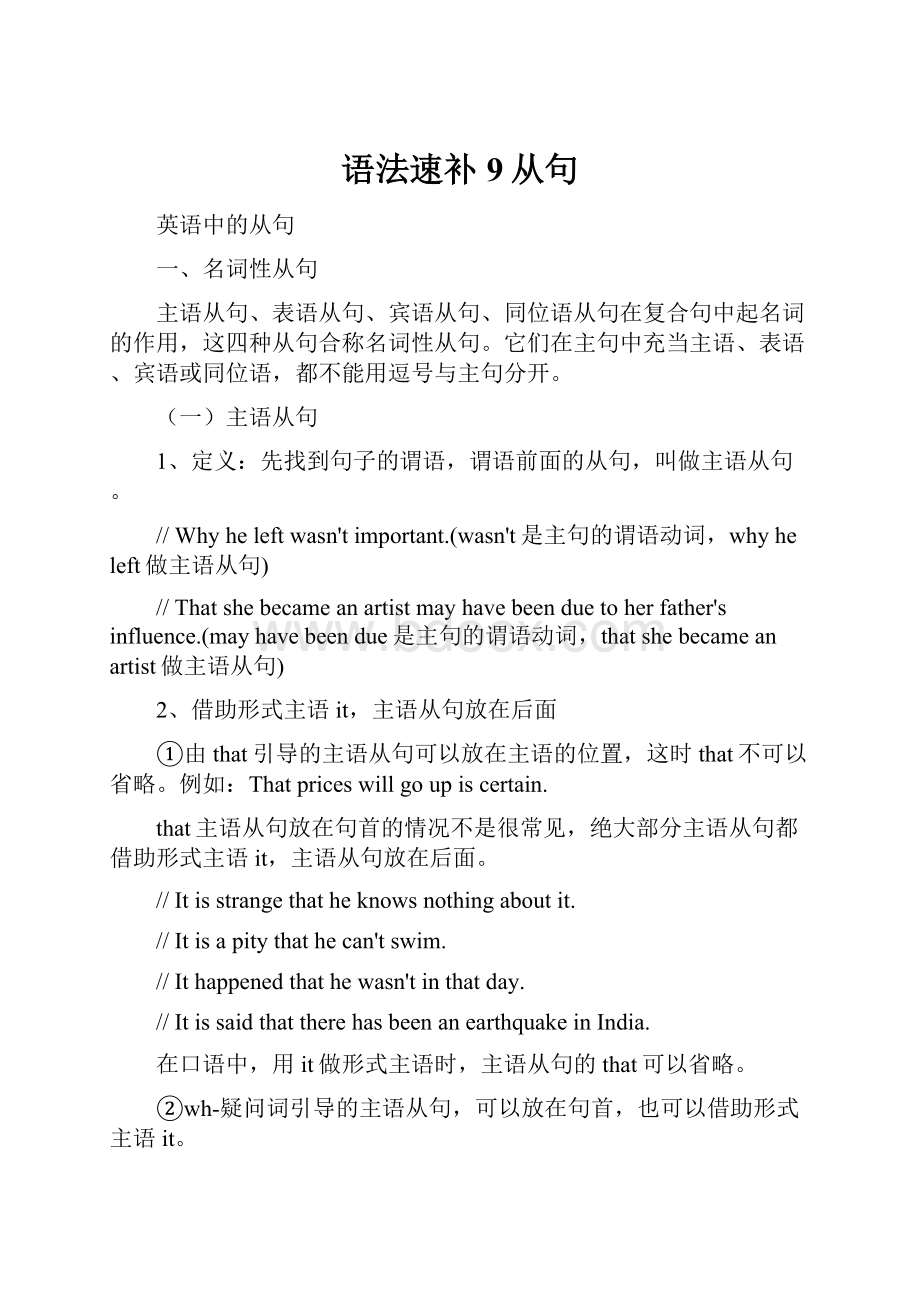语法速补9从句.docx
《语法速补9从句.docx》由会员分享,可在线阅读,更多相关《语法速补9从句.docx(8页珍藏版)》请在冰豆网上搜索。

语法速补9从句
英语中的从句
一、名词性从句
主语从句、表语从句、宾语从句、同位语从句在复合句中起名词的作用,这四种从句合称名词性从句。
它们在主句中充当主语、表语、宾语或同位语,都不能用逗号与主句分开。
(一)主语从句
1、定义:
先找到句子的谓语,谓语前面的从句,叫做主语从句。
//Whyheleftwasn'timportant.(wasn't是主句的谓语动词,whyheleft做主语从句)
//Thatshebecameanartistmayhavebeenduetoherfather'sinfluence.(mayhavebeendue是主句的谓语动词,thatshebecameanartist做主语从句)
2、借助形式主语it,主语从句放在后面
①由that引导的主语从句可以放在主语的位置,这时that不可以省略。
例如:
Thatpriceswillgoupiscertain.
that主语从句放在句首的情况不是很常见,绝大部分主语从句都借助形式主语it,主语从句放在后面。
//Itisstrangethatheknowsnothingaboutit.
//Itisapitythathecan'tswim.
//Ithappenedthathewasn'tinthatday.
//ItissaidthattherehasbeenanearthquakeinIndia.
在口语中,用it做形式主语时,主语从句的that可以省略。
②wh-疑问词引导的主语从句,可以放在句首,也可以借助形式主语it。
//Whenhe'llbebackdependsmuchontheweather.
//Howitwasdonewasamystery.
//Whetherwe'llsucceedremainstobeseen.
//Itisuncertainwhetherthegamewillbeheld.
//It'sapuzzlehowlifebegan.
//Itdoesn'tmattermuchwherewelive.
//Isitknownwherehewent?
(二)宾语从句
1、定义:
及物动词和介词的后面可以接从句做宾语,叫做宾语从句。
//Iguess(that)we'llleavesoon.
//HeaskedwhenwewouldbeinLondon.
//Sheinformedme(that)shewastosendforitthenextday.(that可以省略)
//I'lltellyouwhatIreadintoday'spaper.
//I'llfindoutwhethershe'sinterestedingoing.
//Canyougiveusadescriptionofwhathashappened.
//Shewasshockedbywhatshehadseen.
2、借助形式宾语it,that引导的宾语从句放在后面。
//I'vehearditsaidthatyouhavewonascholarship.
(三)表语从句
1、定义:
系动词的后面可以接句子做表语,叫做表语从句。
//Thefactisthatsheneverlikedhim.
//ThatisnotwhatImeant.
//Thequestioniswhoisresponsibleforwhathashappened.
//Sheisnolongerwhatsheusedtobe.
2、注意:
①thereason做主语时,表语从句用that引导。
//ThereasonHollywoodwasagoodplaceformakingmovieswasthatthesunshinesthereeveryday.
②引导表语从句的that一般不省略。
(四)同位语从句
1、定义:
有些名词的后面可以跟that引导的从句,说明这个名词的内容,这样的从句叫做同位语从句。
所以,只有可以有内容的名词才可以接同位语从句,例如:
fact,message,idea,possibility,conclusion,thought,news,order,report,rumor等等。
that在从句中不做成分,但是不能省略。
//Hehadthefeelingthathewouldnotseeheragain.I'vecometotheconclusionthatitwon'tbewisetodoso.
2、有时为了保持句子的平衡,同位语从句有时和前面的名词分开。
//Therumorspreadthatanewschoolwouldbebuilthere.
3、在少数情况下,名词性从句的其他关联词也可以引导同位语从句。
但if不可以引导同位语从句。
//YouhavenoideahowworriedIwas.
//Ihavenoideawhysheleft.
//ThereissomedoubtwhetherJohnwillcomeontime.
使用名词性从句时注意:
1、名词性从句要用陈述语序。
①Idon'tknowwhobrokethewindow.(宾语从句中关联词who做主语,broke是谓语动词)
②Thelittleboytoldhismotherwherehefoundthecoin.(宾语从句中关联词where不做主语,where后面接主谓部分hefound)
2、感叹句做名词性从句时语序不做变化
//Don'tyouknowhowexcitedIwasthen?
3、时态的呼应
某些从句(特别是宾语从句)中的动词时态,常受主句谓语时态的制约。
①如果主句谓语动词为现在时或将来时,从句中的谓语可以不受影响。
例如:
//Hashetoldyouwhenhereceivedthegift?
//Willyoutellmehowyoutwoaregettingalong?
②如果主语谓语动词为过去时,从句谓语一般要跟着改为相关的过去时。
//Ididn'tknowwheretheylived.
③但是,当宾语从句表示永恒真理时谓语可以不变:
//Thisprovedthattheearthisround.
4、当and连接两个that引导的宾语从句时,and后面的that不可以省略。
//Shepromised(that)shewouldcomeandseehimsometimesandthatshewouldneverforgethim.
二、定语从句
定语从句所修饰的先行词可以是名词或代词,也可以是一个句子。
定语从句通常位于先行词之后,由关系代词或关系副词引导。
(一)限制性定语从句
限制性定语从句修饰先行词,对先行词起修饰作用,紧接先行词之后,无逗号,若省去则原句意思不完整。
引导定语从句的关系代词有who,whom,whose,which,that等。
who,whom,whose用于指人,whose有时也可指物,相当于of which;which用于指物;that既可指人也可指物,但只用于限制性定语从句中。
关系代词除了引导定语从句,替代先行词外,还在从句中担任主语、宾语、定语等。
//The computers and cables which make up the Internet are owned by people and organizations.
//Those who live alone or who are sick may have trouble in getting close to other people.
//The girl whose parents died in an accident is living with her grandmother.
1、当先行词是all,anything,everything,something,nothing等不定代词或先行词前有first,last,any,few,much,some,no,only以及形容词最高级修饰时,只能用关系代词that引导从句。
That is all that I've heard from him.
He's the first person that I'm going to interview this afternoon.
2、关系代词的省略
在从句中作宾语的关系代词常可省略。
关系代词紧跟介词,作介词宾语时不可用that,只可用which或whom引导从句,并且不可省略,但当介词位于宾语从句句末时,作为介词宾语的关系代词仍可用that,也可省略。
//This is one of those things with which we have to put up.
//This is one of those things (which\that) we have to put up with.
3、引导定语从句的关系副词有when,where,why等。
关系副词在从句中作状语,意义上相当于一个“介词+which”的结构。
//Even in comic books where(=in which) there are no words,the stories are fully expressed through the drawings.
//No one knows the reason why(=for which) he was so angry that day.
(二)非限制性定语从句
非限制性定语从句既可修饰先行词,也可修饰整个主句,起补充说明作用,与主句之间有逗号隔开,若省去原句意思不受影响。
不可用that引导非限制性定语从句。
关系词不可省略。
//Heoftencomestoschoollate,whichmakeshisteacherangry.
//Sheeatstoomuch,whichmakesherheavierandheavier.
◆限定性定语从句和非限定性定语从句的区别:
限定性
非限定性
与先行词之间的关系非常密切(删掉后影响全句的意义)
与先行词之间的关系不密切(是一种补充说明,删掉后不影响整个句子的基本意思。
)
不用逗号分开
通常用逗号分开
可用关系代词that
不可用关系代词that
可以省略(that,who,which在从句中担任宾语时可以省略)
不可以省略
可以替代(whom担任宾语时可用who或that替代)
不可以替代
读时不停顿
读时停顿,用降调
只可以修饰先行词,不可以修饰主句或主句的一部分。
修饰整个主句或主句的一部分,此时定有逗号分开,只能由which或as引导。
(三)“介词+which\whom\whose”引导的定语从句
“介词+which\whom\whose”可引导限制性定语从句,也可引导非限制性定语从句,该结构中介词的选择取决于从句谓语动词的固定搭配,或先行词的习惯搭配。
//This is the computer on which he spent all his savings.
//It is written by a person with whom we are all familiar.
(四)as引导的定语从句
as引导的定语从句主要用于“such...as”及“the same...as”的结构中,代替先行词是人或物的名词。
as引导非限制性定语从句时,代替整个主句,从句可位于主句之前、之后或中间。
//These are not such problems as can be easily solved.(as代替先行词problems)
//As is mentioned above,no single company or group can control what happens on the Internet.(as代替主语)
三、状语从句
(一)时间状语从句
引导时间状语从句的从属连词和词组有:
1、when,whenever,while,as,after,before,since,till,until,once等。
//We have learnt quite a lot about it since we came here.
2、as soon as,hardly(scarcely)...when,no sooner...than,each(every) time,the moment,immediately(that)等。
//
As soon as I sent an e-mail message,I received positive
responses.
//The moment he heard the good news,he jumped with joy.
(二)地点状语从句
引导地点状语从句的连词是where,wherever.
//Wherever she went,she took her little daughter with her.
(三)原因、结果和目的状语从句
1、引导原因状语从句的从属连词有:
because,as,since,now(that),seeing that,considering that,in that等。
//Considering that he is a freshman,we must say he is doing well.
2、引导结果状语从句的连词有:
so...that,such...that,so that,that,so等。
//Mickey Mouse is so attractive that the children are reluctant to leave.
3、引导目的状语从句的连词有:
so that,in order that,for fear that,lest等,从句常使用may,might,can,could,would等情态动词。
//We got up early this morning so that we could catch the first bus to the railway station.
(四)条件和让步状语从句
1、引导条件状语从句的连词和词组有if,unless,as(so) long as,on condition that,in case,provided(providing) that,supposing等。
//As long as you have the right equipment,you can use a telephone line to transmit computer data.
2、引导让步状语从句的连词和词组有though,although,whether,even though,even if,no matter what(when,how...),whatever(whenever,wherever,however....)等。
though,even if等引导状语从句可转换成含有as的部分倒装结构,具有强调意义。
其结构为“形容词(副词、动词、名词)+as+主语+谓语”。
//No matter what you may say,I would not change my mind.
//Young as he is,he is quite experienced in this work.(=though he is young)
//Child as he is,he can speak English fluently.(=though he is a child)
(五)方式状语从句
引导方式状语从句的连词有as,just as,as if,as though等。
as if,as though引导的状语从句中,谓语动词常用虚拟语气,表示与事实相反。
//The young man made the experiment just as the teacher had taught him.
//Everything went on as usual as if nothing had happened.